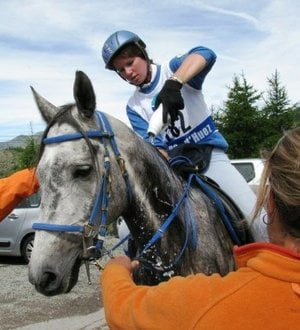Competitive trail riding is a perennially popular equestrian discipline. Endurance riding is even part of the annual eight-discipline FEI World Equestrian Games.
Endurance riding competitions generally range from 25 to 100 miles, with events lasting up to five days. Throughout endurance riding competitions, horses are examined by judges and veterinarians to ensure their overall health and soundness.
Equestrians must carefully prepare themselves and their horses and pace themselves throughout these long-distance rides. Although the first horse (in each division) to finish an endurance ride may be tagged the winner, most long-distance riders consider any competitor who finishes such a taxing event to be a victor.
How can equestrians prepare themselves and their horses for long-distance endurance riding competition? Here are ten tips for training for long-distance trail riding competitions.
Training for Endurance Riding: Check Horse for Confirmation, Health and Soundness
Choose a solid, strong horse with excellent conformation and stamina for long-distance riding. A well-muscled horse (perhaps even with a bit of extra poundage) is optimum for endurance competitions.
A trusted farrier and equine veterinarian are valuable allies for the equestrian endurance competitor. Participating horses need to be in peak form to compete successfully in long-distance events. Farriers and veterinarians may recommend nutritional supplements (especially electrolytes) for horses gearing up for endurance rides.
Training for Endurance Riding: Condition Horse Gradually for Long-Distance Riding
Although many endurance riders advocate 12-week training regimens for long-distance competition horses, a lengthier program is ideal. Some equestrians take up to three years to prepare their horses for long endurance riding events.
To begin training in earnest, most long-distance competitors start with regular schooling sessions of about five miles per day (four to six days per week). By increasing distance and speed gradually, equestrians can build their horses’ strength and stamina for endurance riding.
Eventually, after several weeks, horse and rider teams may be ready for longer rides, finally reaching the goal of about 40 miles per day (for most longer endurance riding competitions).
Training for Endurance Riding: Work Towards Optimum Fitness for Rider
Although the horse does the footwork in a long-distance ride, the equestrian must also be fit and strong for the endurance competition. Cardiovascular fitness, core strength and overall fitness are essential for the long-distance equestrian.
In addition, the endurance rider must be prepared for the possibility of having to lead his or her horse on foot for long distances, if the mount should become injured.
A fair number of endurance riders sign up as race volunteers for a few long-distance events before entering, so they can size up the challenge before participating firsthand.
Training for Endurance Riding: Practice Trail Riding on Various Terrains
Long-distance rides generally take horses and equestrians across all sorts of ground: up and down hills, through water, across fields, into woods and perhaps even along busy highways. Horses must be conditioned to take these variables in stride.
In particular, equine competitors need to possess muscle strength, flexibility and energy to master steep terrain, both climbing and descending.
Training for Endurance Riding: Teach Horse to Handle Obstacles
Unplanned obstacles are a given with endurance riding events. Horses must practice ahead of time to readily accept fallen logs, bridges, water, mud, rocky trails and other surprises.
Training for Endurance Riding: Rehearse Trail Riding in Large Groups
Throughout much of the year, equestrians enjoy riding their horses in arenas (both covered and exposed). Horses may work obediently and easily in these controlled settings. However, endurance riding competitions – with their mass starts – are a completely different deal.
Horses in competitive long-distance events need to be willing to go forward easily in large groups, with unfamiliar horses crowding them. Alpha horses may have to follow, while less aggressive horses may have to take the lead.
Endurance riding competitors may prepare by practicing these variables on group trail rides.
Training for Endurance Riding: Master Trailer Loading and Tying Together
Long-distance trail riding competitions may be held in various regions. Inevitably, competitors will have to transport horses by trailer. Upon arrival and throughout the enduring riding competition, equestrians will need to tie horses – to trailers, hitching posts or tie poles or even to tent stakes. Horses may be placed in temporary stalls or round pens overnight during multi-day endurance riding events.
Competitors do well to practice all of these steps in advance of the endurance ride.
Training for Endurance Riding: Begin Timing Horse and Rider on Distance Rides
Once endurance training is underway, equestrian competitors will want to clock and record their ride times at various distances. Tracking progress is an essential component to successful equestrian endurance riding.
Training for Endurance Riding: Ride Prescribed Course
If possible, long-distance riders will want to ride the prescribed competition course ahead of time. Often, however, this is not an option.
Training for Endurance Riding: Give Horse and Rider a Rest Before Event
Just as marathon runners generally rest for the last few days before a race, endurance riders usually do the same. Giving a well prepared horse and rider a short time off before a long-distance event can be the secret to endurance riding competition success.
By taking these ten steps for training for endurance riding, equestrian competitors may find themselves and their horses well prepared to go the distance and finish in good form.
Sources:
http://www.actha.us
http://www.endurance.net
http://www.horseridingfun.com
http://www.natrc.org






